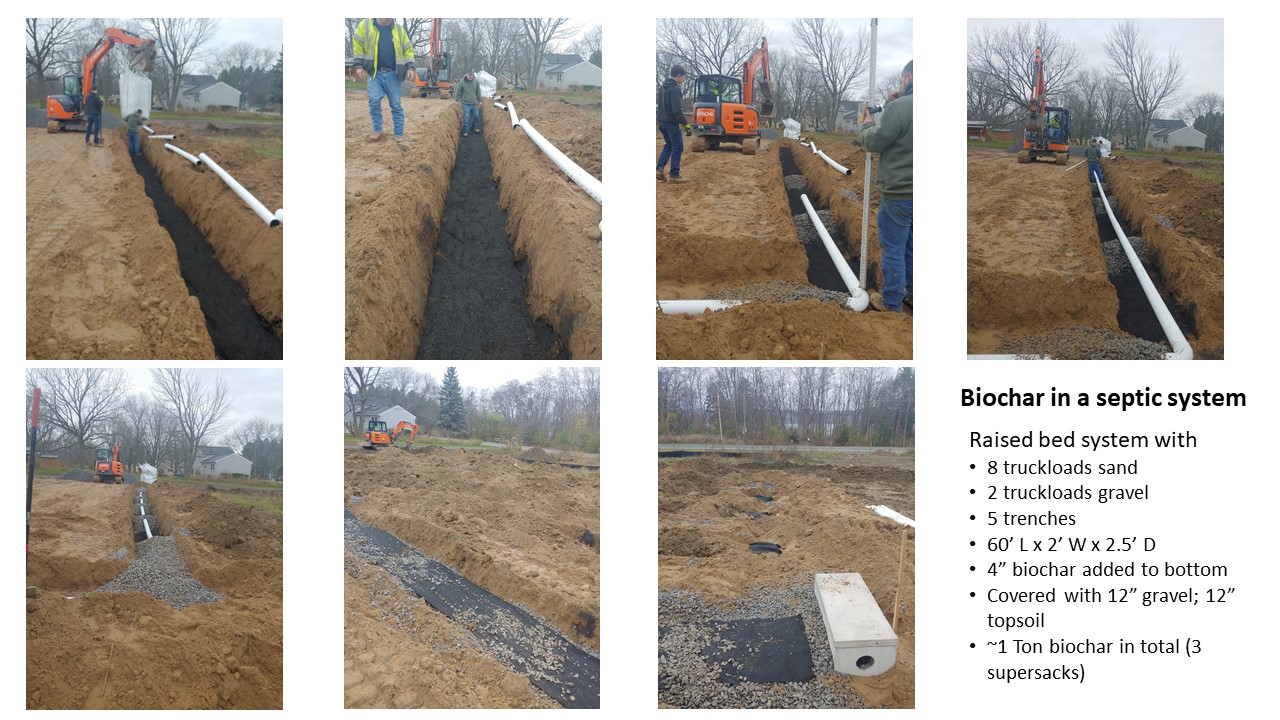For the past several months I have been building my ‘Dwelling on Drawdown’ forever home. As the project name implies, a key emphasis is on sequestering carbon in as many ways as possible. So far biochar has not been the center of attention, but this week that changed as my septic system began to take shape.
First some background. On a freezing cold day last January when the civil engineer, accompanied by the local lake water quality control agent, performed a perc test to see how quickly water drains, the results were (unsurprisingly) not good. In my part of the world heavy clay soils are the norm. During the test, I (also unsurprisingly) waxed poetic about the potential benefits of adding biochar to the leach field – or drain field as it is also called. This was met with more than a little skepticism (and I suspect some eye rolling). However, much to his credit, when the civil engineer sent me the final design for the raised bed system, he outlined how biochar could be utilized effectively without raising regulatory concerns. Seemed like he may have read up on biochar after our little conversation!
Fast forward to the need to source sufficient amounts of biochar for draining the swamp, er… septic system. What type of biochar is best? I don’t know if there is consensus on that as this might just be the first time it has been used in a residential drain field. There is no large-scale biochar production yet in Western New York and I’d already used up my own home-made supply in the water trench. I ended up ordering 6 super sacks from National Carbon Technologies (thanks to Cary Johnson!). NCT is probably one of the largest producers of ‘renewable carbon’ in the United States. Some of the carbon is used in carbon neutral markets but increasingly they are looking at carbon negative markets such as soil amendments. The biochar is made from sustainably sourced wood with high carbon content (>90%) and can be granular or pulverized – I chose granular.
Thankfully, the excavator (Schwartz Excavation) is a family friend and was game to try out the use of biochar. Eight truckloads of sand, mined about 20 miles away, were brought in to raise up the entire drain field. Next a trench was built for a distribution box to send out the effluent into 5 different trenches about 60’L x 2’W x2 1/3’D. The Civil Engineer advised digging deeper trenches and then first adding a layer of biochar to the subsoil. This meant that instead of digging only 2’ deep, trenches were 4” deeper to accommodate the biochar. Super sacks turned out to be the ideal packaging for adding biochar to trenches; it was no fuss, no muss and surprisingly little to no dust during the application. Randy, the excavator, declared that the biochar was too pretty to cover up after the first trench was filled. But cover it they did; first with 6” gravel, then they laid in the perforated pipe, 6” more gravel was added to cover the pipe, next a geotextile was used to cover the gravel to prevent soil from clogging the gravel and finally 12” of topsoil.
In total three super sacks were used or roughly 1 ton for the whole system. The carbon math on that means that nearly 3 tons of CO2e were sequestered in the drain field.
Why add biochar to a drain field? While I think most drain fields could benefit from biochar, living next to a lake makes reduction of excess nutrients and contaminants particularly important. Biochar will also likely help with water management. Given my druthers, I would have mixed the sand with significant amounts of biochar to reduce trucking, improve water management and boost soil fertility, but that will require more study and education of regulators. It might not be cost effective to do that at this stage, though with carbon removal credits beginning to evolve for biochar, that may soon change the economics significantly.
Wouldn’t it be something to design drain fields that are built to serve not only as filtration devices but could purposely be used as soil builders where enriched biochar is harvested every decade or two and used to rejuvenate or decontaminate poor soils and new biochar is added to start the process all over again? Hopefully some environmentally woke civil engineers are already hard at work on this!

